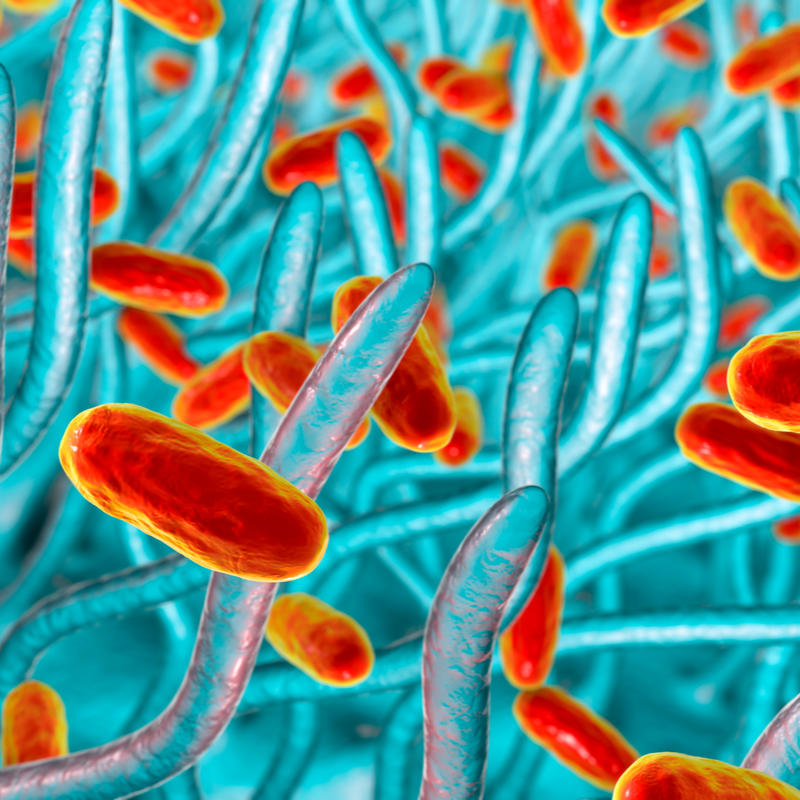
What are Bordetella parapertussis pathogens?
Bordetella parapertussis is a bacterium that comes from the genus Bordetella. These are small, gram-negative rods that are aerobic, i.e. they need oxygen to reproduce. The bacterium can cause a whooping cough-like clinical picture or acute bronchitis by developing a toxin called pertussis toxin. This toxin triggers the coughing fits and allows the bacteria to attach to the mucous membranes of the respiratory tract and multiply. The Bordetella parapertussis pathogen is transmitted via droplet infection, for example by sneezing, coughing or talking. In principle, the infection can occur at any age, but affects children more frequently than average.
What are the histological characteristics of the Bordetella parapertussis pathogen?
The Bordetella parapertussis pathogen is non-motile, i.e. it cannot move on its own. The cells are 0.8 ?m long and 0.4 ?m wide, have pili (fimbriae) on their surface and are surrounded by a capsule. Similar to other Bordetella species, they appear isolated under the light microscope or occur in pairs or groups. Very small colonies form when the bacterium encounters a solid culture medium. The Bordetella parapertussis pathogen is difficult to distinguish from the Haemophilus species.
What are the symptoms of a Bordetella parapertussis infection?
At of a Bordetella parapertussis infection, there is an increased formation of initially thin and later viscous mucus. The disease develops after an incubation period of between 7 and 14 days (maximum three weeks). As a rule, a Bordetella parapertussis infection manifests itself as a less severe clinical picture than an infection with Bordetella pertussis (whooping cough). This applies to both the duration of the disease and the symptoms. The following symptoms occur, similar to those of whooping cough, which can be divided into three disease stages :
- In the first stage of the disease (catarrhal), which begins about one to three weeks after infection, flu-like symptoms appear. Only gradually does a staccato-like cough set in, which initially occurs especially at night and then slowly shifts throughout the day.
- In the second stage of the disease (convulsivum), which begins about 10 to 14 days after the infection, the typical, staccato cough develops. The strong cough bursts are followed by a so-called stridor, i.e. a rapid and deep inspiration. This phase can last for up to six weeks. Typical of the coughing fits is the expectoration of a viscous mucus, which can be accompanied by vomiting. Particularly in young children, choking can occur.
- In the third stage (decrementi), which begins about 4 weeks after the first symptoms, the cough slowly subsides. This so-called recovery phase can last from e weeks to 3 months. During this time, cramping cough attacks can recur and are usually caused by an irritation of the respiratory tract caused by an infection of the upper airways.
What are the possible complications of Bordetella parapertussis infection?
The following feared complications can occur, especially in infants and small children who have a Bordetella parapertussis infection:
- pneumonia,
- Seizures,
- brain damage
An
infection with whooping cough can be prevented by routine vaccination in
childhood. In this case, the child is given a total of five
vaccine doses of acellular pertussis. The vaccinations take place at
2, 4 and 6 months of age and are then repeated as booster vaccinations
between 15 and 18 months and between 4 and 6 years.
How is a Bordetella parapertussis infection diagnosed?
In order to provide the patient with the best possible care as quickly as possible, it is crucial that the infection is diagnosed quickly. To this end, various tests can be used that provide specific detection of Bordetella bacteria. If the IS481 sequence is detected, this can already be regarded as a reliable diagnosis of the Bordetella parapertussis pathogen, as this is often contained in the bacterium . In general, however, it is extremely difficult to distinguish a Bordetella parapertussis infection from whooping cough (pertussis). Bordetella parapertussis infection, however, is usually milder and less often fatal.
In the first disease stage catarrhale and at the beginning of the second stage convulsivum, Bordetella parapertussis can be detected by a nasopharyngeal secretion in 80 to 90 percent of all cases. However, the Bordetella parapertussis pathogen is usually indistinguishable from B. pertussis. For an accurate diagnosis, special culture media as well as a prolonged incubation period are required.
How is a Bordetella parapertussis infection treated?
Particularly in children who are very severely ill with a Bordetella parapertussis infection , inpatient hospitalisation with aerogenic isolation may be necessary. The child remains in isolation until he or she has been given an antibiotic for five days. Depending on the child's health, it may be lifesaving to suction the excess mucus from the nasopharynx, as mucolytic agents or mild sedation usually have only a minimal effect.
If the disease is less severe, antibiotics are administered at the catarrhal stage, which should already relieve the symptoms relatively quickly. If cramping cough attacks have already started , antibiotics are usually ineffective , but are still given to prevent the disease from spreading . The following agents are preferably given :
- Erythromycin for a period of 14 days,
- Azithromycin for a period of 5 days,
- Trimethoprim/sulfamethoxazole is used in patients older than 2 months, if they are intolerant to the macrolide antibiotic or hypersensitive
